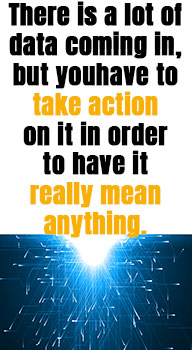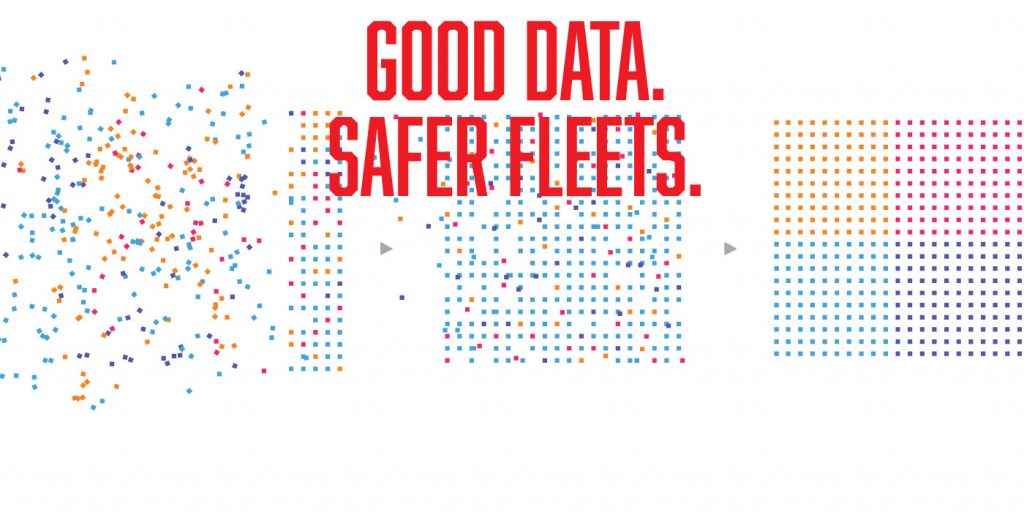Data can tell you lots of cool things about your trucks—where you’re losing out in efficiency, where the slowdown is in the service process or even what risky driving habits and behaviors your drivers engage in. The problem is when you try to talk to others in your fleet about the data, sending around reports of endless numbers, eyes gloss over and you get the big question:
“Great, but what do we do with all this data?”
The answer is act, but how can you be sure you’re analyzing the data correctly and working within your fleet to improve equipment operation? Well, fleet manager, you landed on the right story. We pestered our panel of data-crunching, productivity-boosting trucking telematics experts to bring you the best advice for what you can do right now to improve your equipment operations. And today we’re focusing on safety.
What data can help you improve your fleet’s safety?
These data points are typically linked to alerts generated by your telematics system. Most of them will alert you to the biggest safety threats:
• hard braking;
• rapid acceleration;
• roll stability instances;
• forward collision mitigation system warning and activation; and
• lane departure warnings.
“How often drivers get following distance alerts or overspeed alerts, for example, will identify opportunities for fleets to determine how often drivers are following those company standards,” said TJ Thomas, director of marketing and customer solutions–controls with Bendix Commercial Vehicle Systems.
How often is ‘often’? Any tips for identifying a behavior?
Let’s turn to Chris Orban, vice president of data science for Trimble Transportation, for the answer:
“The most important thing a safety manager can do when analyzing driver safety data is consider the whole picture; it’s critical to compare apples to apples in order to identify outliers,” he said. “For example, a driver who frequently drives urban routes with heavy traffic during the day will likely have more hard-braking events than a driver who usually drives long highway routes at night when there is no traffic.
“In the heavy traffic environment,” he continued, “hard braking events don’t necessarily mean unsafe driving behavior—sometimes hard brakes may be necessary to avoid a collision, and you may want to recognize that driver for doing their best to prevent an accident. However, if the night driver has even a couple of hard-braking events at 3 a.m. when there are hardly any other vehicles on the road, it’s possible that behavior should be more closely scrutinized for potential risk.”

It is all about finding the outliers in data, which can indicate that
TJ Thomas, Bendix
there are behaviors or situations that can be addressed to improve safety.
Stephanie Voelker, Geotab’s vice president of enterprise sales solutions, echoed that idea when she highlighted an assumption that’s easy to make: that all alerts equal risky driving behavior. “In some instances, a driver might engage in risky driving to prevent an impending accident,” she pointed out.
“Using the example of harsh braking, fleet managers should consider various conditions like driver behavior over distance, for example, meaning they should consider the number of harsh braking incidents per 100 miles of driving.”
Another technique offered by Bendix’s Thomas is to compare one driver’s data to the company as a whole:
“To identify occasional behavior, look at how many active emergency braking (AEB) activations a driver got today or this week and then ask, ‘How does that compare with the company standard?’” he advised. “A starting point to indicate larger trends is to monitor how a driver has developed over time—but it can also be beneficial to compare that driver’s performance vs. other drivers driving the same route, or drivers driving the same kind of vehicle, to have good apples-to-apples comparisons.”
I’m a fleet manager, not a data scientist! This sounds like a lot of analysis.
Your telematics platform of choice should be able to bring these data points and analysis interpretations to your attention without you having to do too much digging (though some digging is likely required.)
“Using tools like reports and dashboards can indicate the difference between an occasional behavior and a trend,” confirmed Idil Osman, Verizon Connect product success manager.
“You can also look at clusters of events rather than analyzing them in solitude,” Trimble’s Orban noted. “Instead of looking just at hard brakes or roll stability controls, for example, are there any clusters where several of these events happened in close succession? That will likely tell you more about a driver’s behavior than just one solitary event.”
But I’m hyper-focused on fuel efficiency data, I don’t have time for this.
It’s time to make time. Let’s put the important safety aspect aside for a moment and recognize that risky driving behavior impacts your MPG.

“Fleet managers need to see the impact poor driving behavior is having on the health of their vehicles and the total negative costs to their operations,” Verizon Connect’s Osman said. “Harsh braking, fast starts, speeding and hard cornering can negatively impact fuel economy, vehicle wear and tear and insurance cost. A focus on these data points, even just in the short term, can tremendously improve operational safety and reduce cost.”
“Consider the driver who is getting dramatically better MPG than the rest of his peers hauling similar freight with a similar truck. Is he driving more carefully?” Trimble’s Orban added. “On the flip side: is there a driver who is getting poor MPG compared to his peers? If so, why? Is he driving too fast? Stopping suddenly? An MPG analytics platform could track this and provide valuable insight into driving behaviors.”
Point taken.
Any other telematics options that could improve my visibility into the driving behavior event?
In-cab video. The segment has grown rapidly over the past year and shows no sign of slowing down.
“The value of onboard video is often talked about in terms of assisting with exoneration, but it also is a great driver coaching tool because it is an objective source of information,” Trimble’s Orban said. “Safety managers can use it to increase visibility into the full context of safety events, as well as show the videos to drivers in one-on-one conversations.”
Video can also help reduce accidents by discouraging risky driving behavior. The drivers know it’s there and are more likely to be on their best behavior.
Total number of speeding violations or harsh driving events like sudden braking and accelerations are key metrics that fleet managers can observe over a period of time.
Idil Osman, Verizon Connect
“And with an added bonus of artificial intelligence, fleet managers can understand which incidents are the most dangerous, which eliminates the need for time-consuming reviews,” Verizon Connect’s Osman said, referring to Verizon Connect’s Integrated Video platform.
Many telematics providers offer video integration, though how they go about it may differ. Trimble’s Video Intelligence solution, for example, also offers an integrated video solution. Other providers like Geotab offer integrations with existing video platforms. In Geotab’s case, the company announced during its Connect conference in January that it has integrated with Lytx to add to its portfolio of video integrations including SmartDrive, Rosco Vision, SmartWitness, Zone Defense and others on the Geotab Marketplace.
Bendix employs video in its Wingman Fusion collision mitigation system, a trait common to many of the latest cutting-edge safety systems.
“People want to see the video first because it showed what happened in a manner that everyone can understand quickly,” Bendix’s Thomas said. “Did the truck get cut off? Did the forward vehicle slam on its brakes? Did the truck depart its lane? All that, and more, can be seen from the video, but when you overlay the data from the truck you get a much clearer picture.
“You can tell when the alerts activated, as well as when the driver de-throttled or hit the brakes. You can also tell how far the truck was from the forward vehicle when all this happened. All of this can be used to train the driver in a manner he or she best understands.”
RELATED: Read more about the pros and cons of in-cab video in our recent feature story below.
What are the best practices for training drivers using data? How can I make it approachable and important to them?
Drivers are a proud, hard-working bunch that enjoy their freedom. While technology adoption curves have quickened in the past five years, the fear of alienating drivers with too much technology that could be perceived as “Big Brother” in the cab still lingers.
So how do you bring data into the discussion, talk about technology that’s in the truck and get drivers to buy in?
“It’s critical to talk openly and honestly with drivers to ensure you’re communicating that the safety data coming in isn’t necessarily a reflection of a lack of skill or bad intent,” Trimble’s Orban said. “The best starting point when an event happens is to explain to a driver the objective data that’s coming in—hard brake, roll stability control, speed, etc.—to tell them what the truck recorded. That said, it’s equally important to also connect with the driver about what their own personal experience was, what was going on for them at the time of the event, and so on.”
Best practices point to that conversation happening within 48 hours of the event, and it’s best done in person or, at least, over the phone. Given the current proliferation of video conferencing during the Coronavirus Stay At Home orders, that could be a good middle-ground option for drivers who are on the road while you’re in the office or working from home.
When you begin to add technology into the cab and your training process, Bendix’s Thomas suggested starting the conversation by explaining that the system is an extra set of eyes and ears designed to help them if they get into an unexpected bad situation.
“A very effective approach to coaching is to be very specific: When coaching a driver on following distance, for example, show video and data of an actual event that this driver experienced very recently,” he said. “This can then be compared to general performance metrics to highlight opportunities for change.”
Here’s a “for instance”:
“A level 4 Electronic Stability Program event can be severe,” Thomas said. “It is somewhat likely the vehicle would have rolled over or lost control, possibly leading to a crash. If the data comes back to show any given driver had one or more level 4 ESP events, he or she can be coached to slow down. They can be shown a training video where Bendix demonstrates a severe rollover maneuver with ‘system on’ and ‘system off’ to explain to the driver what is happening and that they are driving on the edge since it’s very difficult to know that while you are in the cab.”
What’s this safety gamification I hear about?
Openly sharing the data, building driver scorecards and turning it into a safety-focused, better driver behavior building game can increase engagement with your safety telematics platform of choice and inject some much-needed fun into a serious subject and touchy training process.
Fleets should look at the safety related data points that will help them identify the external factors of its most common risky driving incidents.
Stephanie Voelker, Geotab
“By rewarding drivers for achieving goals and milestones, fleet managers can measure how effective their coaching efforts have been without focusing on potentially confusing or less exciting data points,” Osman said.
“It helps the driver know what they are doing well and where they need to improve,” Geotab’s Voelker said. “Driver scorecards compare a driver on how safely they drive by calculating the number of risky driving incidents that happen while they are on the road versus other drivers in similar vehicle types in similar rural or urban areas. In addition, the data can be used to develop customized in-vehicle alerts and training sessions to target and successfully improve driver habits.”
What about safety-related alerts? I’m getting them, but should my drivers?
Depending on your fleet and platform, drivers may have complete visibility of the notifications, or none at all. It all depends on your needs and training methods. Most telematics platforms’ notification options are scalable to what you need.
“While the majority of instant alerts and notifications are tailored to serve fleet managers, drivers are able to receive email alerts to notify them about their harsh driving events,” Verizon Connect’s Osman noted. “Push notifications on mobile apps can be distracting for a driver while they’re on the road, which doesn’t curb risky driver behavior. Email notifications are a good balance of keeping the driver in the know without being a distraction.”
To minimize distraction, Geotab GOTalk uses text-to-speech to provide real-time spoken alerts to drivers based on predefined and customized safety rules by the customer. If a driver violates one of the rules, GO Talk will provide immediate verbal coaching feedback to the driver.
Regardless of the level of visibility, Trimble’s Orban reiterated the importance of making contact with your drivers soon after the event.
“They may just see a roll stability control event or lane departure notification, and know that the fleet manager will see it, but the alert doesn’t necessarily tell them what to do,” Orban said. “This can lead to growing stress and concern in the driver’s mind as they wait for the safety manager to call. This is why it’s so crucial to reach out to the driver as soon as possible to get the full story about what happened.”
Wow, that’s a lot of great info to get started. Anything else I need to know?
Remember that your telematics and safety system solutions suppliers are there to help. Have a question about the data or need tips and tricks to take your driver safety training to the next level? They’re just a phone call or email away and they can look at the same data that you’re looking at to provide tailored solutions.













